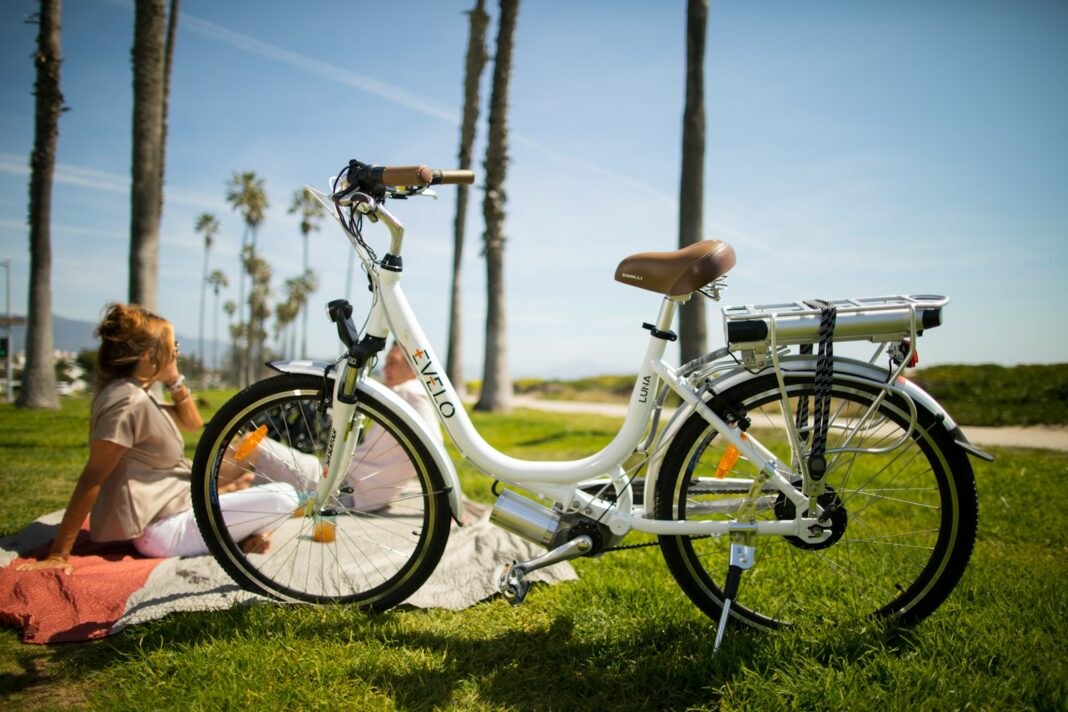Introduction
As cities around the globe grapple with increasing traffic congestion and pollution, electric bicycles (e-bikes) are emerging as a sustainable solution to these challenges. Combining the traditional appeal of cycling with cutting-edge technology, e-bikes offer an eco-friendly and efficient way to navigate urban environments. This article provides an in-depth look at electric bicycles, their evolution, operational mechanics, benefits, and the pivotal role they are poised to play in the future of transportation.
The Journey of Electric Bicycles: From Concept to Reality
Historical Background
The concept of electric bicycles has been around for over a century, with the first patents appearing in the late 1800s. Early prototypes were primitive, characterized by heavy motors and limited battery life. However, these initial efforts laid the foundation for the development of modern e-bikes, which are far more sophisticated and practical.
Advancements in Technology
The evolution of electric bicycles has been closely tied to advancements in battery and motor technology. The advent of lightweight, high-capacity lithium-ion batteries in the early 2000s revolutionized the e-bike industry, allowing for longer ranges and more efficient power delivery. Additionally, improvements in motor design have led to quieter, more powerful, and energy-efficient e-bikes, making them a viable option for daily commuting and recreational use.
Understanding How Electric Bicycles Work
Key Components of an E-Bike
Electric bicycles consist of several critical components that distinguish them from traditional bikes:
- Motor: The motor, which can be located in the front, rear hub, or at the crankshaft (mid-drive), provides the necessary power to assist the rider. Mid-drive motors are particularly popular for their balanced weight distribution and efficient power delivery.
- Battery: The battery stores the electrical energy needed to power the motor. Lithium-ion batteries are the standard due to their high energy density and long life cycle.
- Controller: The controller acts as the interface between the rider and the motor, regulating the power flow based on the rider’s input.
- Display Panel: Many e-bikes feature a digital display that shows key information such as speed, battery level, and assistance mode, allowing the rider to monitor and adjust their ride in real-time.
Modes of Operation: Pedal-Assist and Throttle
Electric bicycles typically offer two modes of operation:
- Pedal-Assist: In this mode, the motor provides assistance only when the rider is pedaling. The level of assistance can usually be adjusted, offering a range from light to substantial help, which makes cycling less strenuous, especially on inclines or over long distances.
- Throttle Control: Throttle mode allows the rider to engage the motor without pedaling, much like a scooter. This feature is particularly useful for quick bursts of speed or when the rider needs a break from pedaling.
Battery Life and Charging
Battery life is a crucial factor in the performance of an electric bicycle. The range, or the distance an e-bike can travel on a single charge, varies depending on several factors including battery capacity, terrain, rider weight, and the level of motor assistance. Typically, most e-bikes offer a range of 20 to 70 miles per charge. Charging times can vary, with most batteries requiring 3 to 6 hours for a full charge.
Why Electric Bicycles Are Gaining Popularity
Environmental Benefits
One of the most compelling reasons for the rising popularity of electric bicycles is their environmental impact. E-bikes emit no pollutants, making them a clean alternative to cars and motorcycles. They help reduce urban air pollution, decrease traffic congestion, and contribute to the reduction of carbon footprints, aligning with global efforts to combat climate change.
Cost Efficiency
Although the initial cost of an electric bicycle may be higher than that of a traditional bicycle, the long-term financial benefits are significant. E-bikes are inexpensive to operate, with minimal maintenance costs and no need for fuel. They can also reduce or eliminate the need for public transportation, parking fees, and even car ownership in some cases.
Health and Fitness Advantages
Contrary to the misconception that electric bicycles are “cheating,” they actually promote physical activity. The pedal-assist feature encourages regular exercise by making cycling more accessible, allowing riders to cover greater distances and tackle challenging routes without excessive strain. This can lead to improved cardiovascular health, enhanced muscle tone, and better mental well-being.
Accessibility for All
Electric bicycles open up cycling to a wider audience, including older adults, individuals with physical disabilities, and those living in areas with hilly terrain. The motor assistance provided by e-bikes allows these groups to enjoy the benefits of cycling without being limited by physical exertion or challenging topography.
Challenges Faced by Electric Bicycles
High Initial Costs
The price of electric bicycles can be a significant deterrent for many potential buyers. High-quality e-bikes typically range from $1,500 to $5,000, with premium models costing even more. However, as the technology becomes more widespread and production scales up, prices are expected to decrease, making e-bikes more accessible to a broader audience.
Battery Life and Performance
Battery performance remains a critical concern for electric bicycle users. The range of an e-bike can be affected by various factors such as rider weight, terrain, and weather conditions. Over time, batteries also degrade, leading to reduced capacity and shorter range. Regular maintenance and proper charging habits can help mitigate these issues, but battery replacement costs should be considered.
Regulatory and Legal Considerations
The legal status of electric bicycles varies significantly across different regions. Some areas treat e-bikes similarly to traditional bicycles, while others impose stricter regulations, requiring registration, insurance, and even a driver’s license. Understanding and complying with local laws is essential for e-bike users to avoid fines and legal issues.
Types of Electric Bicycles and Their Uses
City E-Bikes
City or urban e-bikes are designed for commuting and everyday use in urban environments. They feature a comfortable riding position, integrated lights, and often include practical accessories such as racks and fenders. City e-bikes are ideal for short to medium-distance commuting, errands, and leisurely rides around town.
Mountain E-Bikes (e-MTBs)
Mountain e-bikes are built for off-road adventures. With robust frames, powerful motors, and advanced suspension systems, they are designed to handle rough terrain and steep climbs. E-MTBs are popular among outdoor enthusiasts who want to explore trails and rugged landscapes without being limited by their physical fitness.
Folding E-Bikes
Folding e-bikes are compact and portable, making them an excellent choice for city dwellers with limited storage space or those who need to combine cycling with public transportation. Despite their small size, many folding e-bikes offer impressive power and range, providing a convenient and efficient way to navigate urban areas.
Cargo E-Bikes
Cargo e-bikes are designed for carrying heavy loads. With sturdy frames and large cargo capacities, they are often used by families and businesses for transporting groceries, packages, and even children. Cargo e-bikes are increasingly being adopted by delivery services as a sustainable alternative to vans and trucks for last-mile deliveries.
The Future of Electric Bicycles
Technological Innovations
The future of electric bicycles is bright, with ongoing advancements in battery technology, motor efficiency, and smart features. Researchers are working on developing batteries with higher energy densities and faster charging capabilities, which could significantly increase the range and reduce the charging time of e-bikes. Additionally, integration with smart technology, such as GPS navigation, mobile apps, and real-time performance monitoring, is expected to become more common, enhancing the overall user experience.
Urban Integration
As cities continue to grow and the need for sustainable transportation solutions becomes more urgent. Electric bicycles are likely to play a central role in urban mobility. Many cities are already investing in e-bike infrastructure, including dedicated lanes, parking facilities, and charging stations. E-bikes are also being integrated into public transportation systems, with bike-sharing programs becoming increasingly popular in urban centers around the world.
Environmental Impact
The widespread adoption of electric bicycles has the potential to make a significant positive impact on the environment. By reducing the reliance on cars for short trips, e-bikes can help lower greenhouse gas emissions and improve air quality in cities. As more people switch to e-bikes, the cumulative effect could lead to quieter, cleaner, and more livable urban environments.
How to Choose the Right Electric Bicycle
Assessing Your Needs
Choosing the right electric bicycle begins with assessing your personal needs. Consider how and where you plan to use the e-bike. For daily commuting, a city e-bike with a comfortable riding position and practical features might be ideal. If you’re interested in off-road adventures, a mountain e-bike with a powerful motor and suspension system would be more suitable.
Evaluating Key Features
When selecting an e-bike, it’s important to evaluate key features such as motor power, battery capacity, range, and weight. A higher-capacity battery will provide a longer range, while a more powerful motor will offer better performance on hills and with heavy loads. Additionally, consider the bike’s build quality, comfort, and any additional features like integrated lights, racks, or fenders that might enhance your riding experience.
Budget and Financing
Electric bicycles come in a wide range of prices, so it’s important to set a budget before shopping. While it’s tempting to opt for a cheaper model, investing in a quality e-bike will likely provide better long-term value and reliability. Some retailers offer financing options, and in certain areas, government subsidies or incentives may be available to help offset the cost of purchasing an e-bike.
Frequently Asked Questions About Electric Bicycles
1. How fast can electric bicycles go?
Electric bicycles are typically designed to assist riders up to speeds of 20 to 28 mph, depending on the motor power and local regulations. Once this speed is reached, the motor assistance cuts off, though riders can continue pedaling faster if they choose.
2. What factors affect an electric bicycle’s range?
Several factors influence the range of an electric bicycle, including battery capacity, terrain, rider weight, weather conditions, and the level of motor assistance. Frequent use of high power levels or riding in hilly terrain will reduce the range. While moderate assistance and flat terrain can help maximize it.
3. How should I maintain my electric bicycle?
Regular maintenance of an electric bicycle involves keeping the battery charged and properly stored, ensuring the motor and electrical components are clean and dry, and checking the tires and brakes for wear. It’s also advisable to have the e-bike professionally serviced at least once a year to ensure optimal performance.
4. Are electric bicycles legal on bike paths and trails?
The legality of electric bicycles on bike paths and trails varies depending on local laws. In many areas, e-bikes are allowed on the same paths as traditional bicycles, especially if they meet certain power and speed restrictions. However, some trails may have specific rules prohibiting motorized vehicles, so it’s important to check local regulations.
5. Can I convert a regular bicycle into an electric one?
Yes, it is possible to convert a traditional bicycle into an electric bicycle using a conversion kit. These kits typically include a motor, battery, and controller. However, it’s important to ensure that the bike’s frame and components are strong enough to handle the additional weight and power.
6. What should I look for in an electric bicycle warranty?
When purchasing an electric bicycle, it’s important to consider the warranty offered by the manufacturer. Look for warranties that cover the motor, battery, and electrical components for at least two years. A good warranty can provide peace of mind and protect your investment in case of defects or issues.
Conclusion
Electric bicycles are rapidly becoming an essential part of the urban transportation landscape, offering a practical, sustainable, and enjoyable way to get around. Whether you’re commuting to work, exploring the outdoors, or running errands. An e-bike can enhance your mobility while reducing your environmental impact. As technology continues to advance and cities become more accommodating to cyclists. The future of electric bicycles looks promising and bright.












